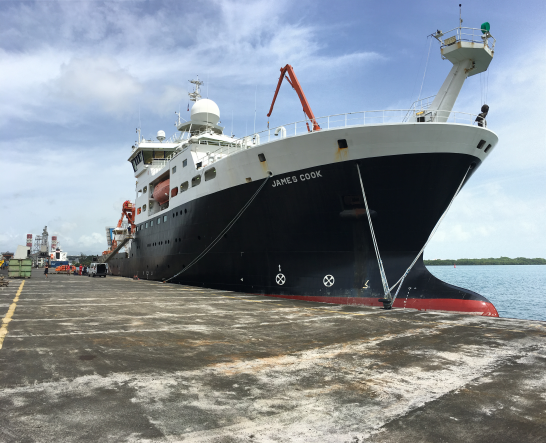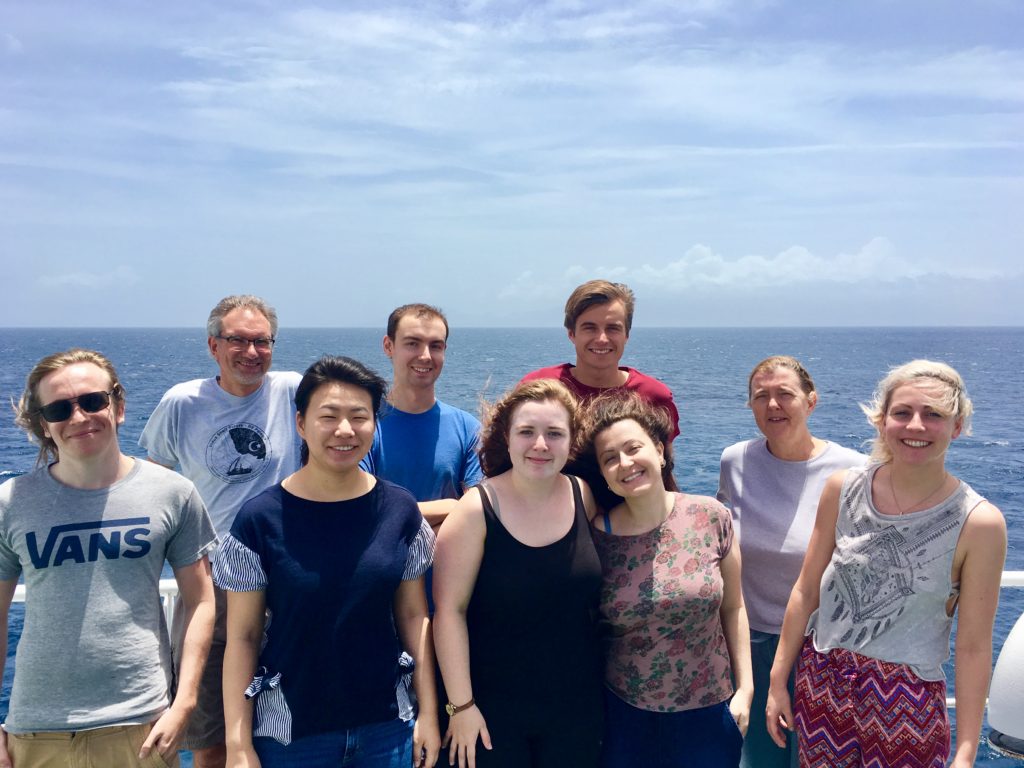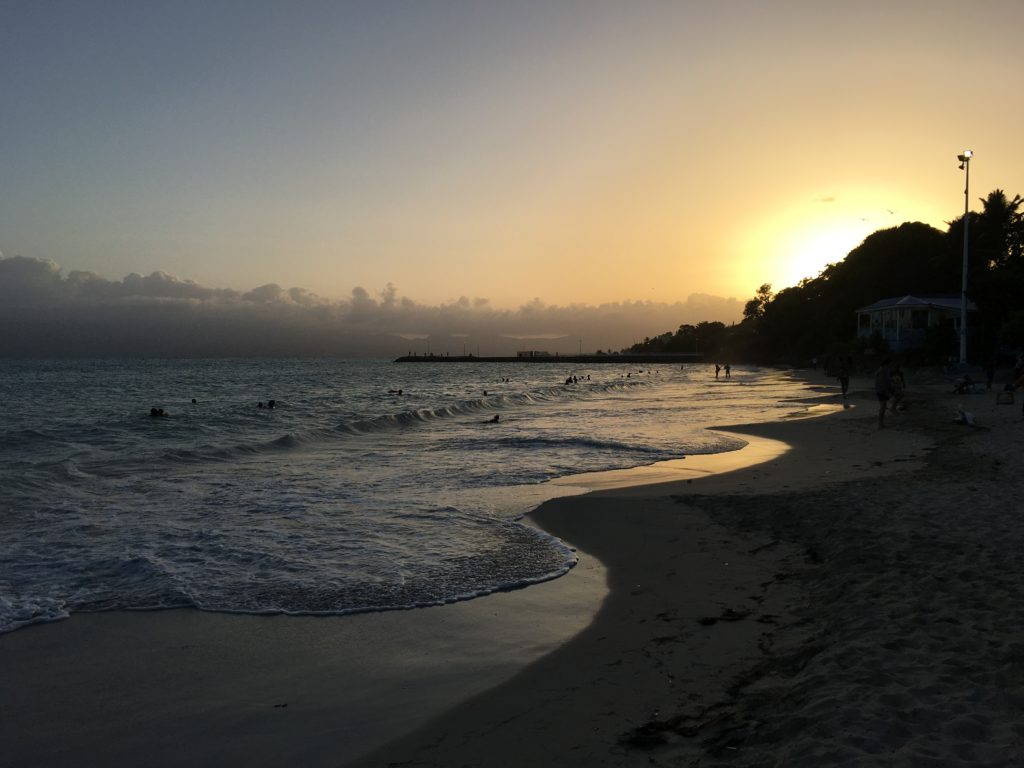Homeward Bound
5 weeks away from home and we’re finally sailing back to port as JC149 comes to an end. As much as I am very excited to get back to London for some home comforts and see my friends and family, I can’t really believe it’s all over so quickly.
The last week has been a mixed bag of events to say the least. We were able to shoot a bonus 7th line with the towed streamer parallel to our previous survey lines across the fracture zones. Tim got 30 mins of ‘experimental’ seismic at the end of the line with some varying shot times too. We had a final weekend BBQ on Saturday which was much less wet and windy than our last attempt over the Bank Holiday, and felt like a real celebration as we near the end of this cruise. As we transit back to Pointe a Pitre, watch keepers are gradually transitioning to more sociable working hours, which means I’m finally seeing some sunshine as my night shifts come to an end!
As I sat excited (and a little nervous) at Heathrow all those weeks ago I had no idea what I was about to join, and so as we wrap up here, I’ve put together a bit of a summary of my time aboard and try and shed some light on what life at sea has really been like.
The science
Only 8 weeks ago, I was sitting some of my final university exams, including a module in exploration seismology. I spent weeks over Easter revising the main principles of acquisition geometries and survey fold, the hydrophone spacing and the shot interval and yet here on back deck really is a 13-gun array and 3km of towed streamers. As with many things in geology and geophysics, it’s one thing to learn in a lecture theatre but it’s another thing being able to see it for yourself. I’ve come to appreciate the huge scale of marine seismic acquisition. It’s all very well having the science party in the lab eagerly awaiting a seismic section to interpret, but getting to that stage requires a fleet of people working all hours on deck to manoeuvre the equipment in and out of the sea – deck crew, petty officers, cadets, airgun technicians, OBS teams. And of course the team that know the vessel better than anyone, the officers on the bridge. I can’t imagine we’d have much data to play with if it had just been myself, Jenny and a team of scientists trying to throw the grapple hooks to bring in the OBS and operating cranes.

I was also able to see the magnetometer deployed and recovered on a couple of occasions, which provided a nice conclusion to my MSci work and my degree, having spent 4 months working with the magnetic data from last year’s cruise. I have come to appreciate that even transiting at 10 knots with the maggie out, the amount of ground covered is pretty small. My data set contained 120 cruises and I can now see the huge scale of operation to collect that much data.
It’s not all plain sailing
Pardon the pun, but I have learnt that in marine data acquisition things do go wrong sometimes. We lost 2 OBS, we had a night time OBS recovery where the lights didn’t work, we’ve even had exploding seismometers, and at one stage in firing we had airgun failure and had to loop back and restart. These all pale into insignificance, however, compared to the remarkable successes of the cruise. In just 34 days we have deployed and recovered 150 OBS stations, shot active source seismic across all 6 planned surveys and an additional 7th line in our contingency time at the end. We have collected swath bathymetry data, magnetic measurements and successfully dredged to collect samples directly from the oceanic crust. From the first reaction on Tim and Jenny’s faces to the first printed seismic line, to the final sail back to land, it’s fair to say JC149 Leg 3 has been a resounding success.
Ship life
I never really imagined what it would be like working 24hrs a day on a ship. It’s true, with no weekends you do tend to lose a sense of days and find yourself guessing what day it is based on what’s for dinner that night. Working midnight until 4am, you can never be really sure how to greet people either. Good morning? Goodnight? But there is a funny sense of comradery on the night shift as you tuck into a meal at 2am that you’re not sure whether to call breakfast or dinner. This is the first time I’ve ever been at sea, I haven’t so much as crossed the English Channel by ferry, and so I was struck hard with sea sickness in the first 2-3 days. Rumour has it that I’ve now got the land sickness to look forward to, and I shouldn’t be surprised if I find myself walking in very wobbly lines for a few days. Although it’s easy to moan about all the things you miss back at home – considering we’re several hundred miles from land I have been treated very well. Cooked buffet meals 3 times a day, fresh bed sheets delivered to your door every week, a shower more powerful than the one in my own London flat, wifi access (mostly), and of course the Caribbean sunshine. The Purser and the Galley team really make sure that if you’re away from home for so long, at least it’s comfortable and enjoyable.

The end result
Data collection and research science on this scale is a huge project but it’s immensely rewarding. There are some really satisfying short term goals whilst you’re on board. After the first seismic line that was printed, geoscientists flocked with colouring pencils to give it our best interpretation. And the dredging days were particularly exciting for hands on science. But the data acquired on this cruise fits into the much broader goals of the VoiLA project. Several years lie ahead now to understand what we have recorded in our time here. Rob has some data at last from leg 1 to push on with his PhD, we have dredged samples from the sea floor to be passed onto the petrologists in the research group, and some of the team will be working with the highest resolution seismic imaging technique, full waveform inversion (FWI) to understand the results from leg 3. I have been very lucky to have even played a small role in this fantastic research group.
And now?
With the exception of 2 cadets there is a whole crew change over, as the RRS James Cook sets sail to the Canary Islands for another project. For those that have been on since April 17th including Jenny, Tim and Rob, they are rewarded with a precious few days relaxing on land before flying home.
